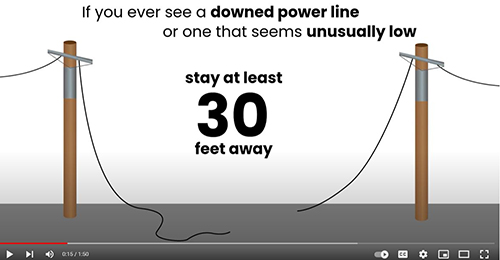Downed power lines can be dangerous, even from a distance. Watch the video below to learn what to do if you see low-hanging or downed power lines.
Electrical Safety - Residential - New Hampshire Electric - Liberty

Planting a tree? Installing a fence? Planning a home improvement? Call 811.
Did you know it’s the law to make this call? Electric power lines, natural gas pipelines, water pipes, communications lines, and other utility services can be within a few feet of the ground’s surface. Not knowing where they are can result in personal injury, property damage and neighborhood service interruptions. Even a small dent or a scrape can cause damage, resulting in a leak or service-wide disruptions.
Purchasing an electric generator as a standby system can help you prepare for the possibility of a power outage. However, generators can be expensive to run and maintain, noisy, and, most importantly, may pose a serious safety hazard if not used and installed according to the manufacturer's instructions. Be sure to follow all safety guidelines when using a generator.
Powerlines, substations, and transformers all contain “live” parts that can be dangerous to contact. Whether uninsulated overhead powerlines or underground powerlines, it’s important to exercise caution around any electrical system. If you see a downed power line, or any other wire, stay at least 30 feet away from the wire (about the length of a school bus) and secure the area to keep others away.
With all the appliances, tools, cords and plugs we use in everyday life, it's important to know how to use them safely. Keep yourself and your family safe by treating power with respect.
Most electrical fires can be traced to overheated circuits and overloaded equipment. When abused, insulation may melt or burn, exposing live wires. Learn what to do in the event of a fire and how to avoid having one.
Trees can cause power outages when branches rub against power lines, break and fall on lines or when trees are blown over on to power lines during storms. However, do not attempt to prune the trees yourself. Learn more on how you can request a tree trimming from Liberty Utilities.
Carbon monoxide, or CO, is a normal by-product of fuel combustion, but high levels of it indoors can be dangerous to your health. Typical heating fuels (oil, coal, wood, gasoline, kerosene, diesel fuel, or natural gas) can create carbon monoxide. Carbon monoxide has no odor, color, or taste, but can cause serious health issues. Take steps to make sure your home is protected.
Underground electrical service has several benefits. There are less power disruptions due to tree contact, wires are out of site and there are no utility poles to contend with locally. However, it’s important to use caution around associated underground infrastructure.
Our goal is to restore power as quickly as possible, but our priority is always to make sure we are not putting our employees or members of the public at risk while doing so. The Occupational Safety and Health Administration (OSHA) and truck manufacturers state that utility workers cannot operate bucket trucks in elevated winds or adverse weather conditions. Poor weather conditions could cause an employee to come into contact with flying debris or lose control of materials or equipment they are handling, posing a risk to themselves and the public.
Prior to utilizing a bucket truck, a proper risk assessment is conducted to determine the hazards and the controls to be used. As soon as our crews are able to do so safely, rest assured we will be out in the field working on getting our customers back up and running.
For emergencies, call 911 then call Liberty.
In an effort to help educate first responders so that they can perform their jobs safely and effectively, Liberty Utilities provides valuable information on responding to electrical emergencies.
The workplace is a hotbed for electricity interaction. Learn more about how you can protect yourself from a shock.
Knowing how to use electricty safely is an important thing to learn early. We have put together some safety information about the common day-to-day electronics and appliances that kids are around or likely to use.
